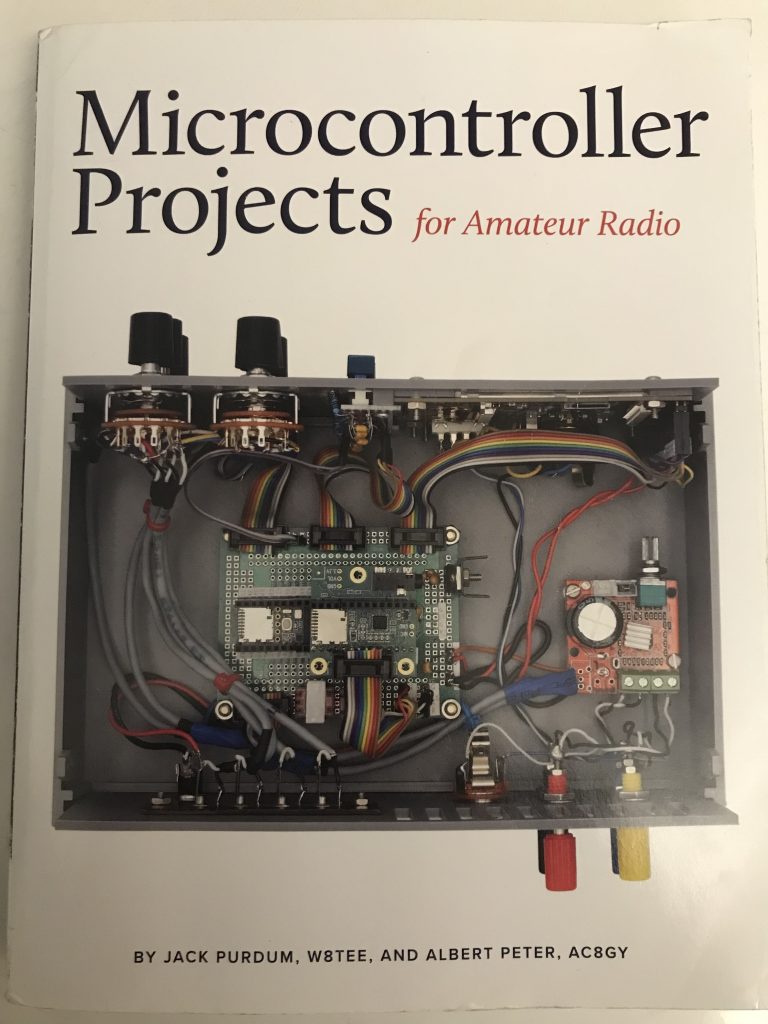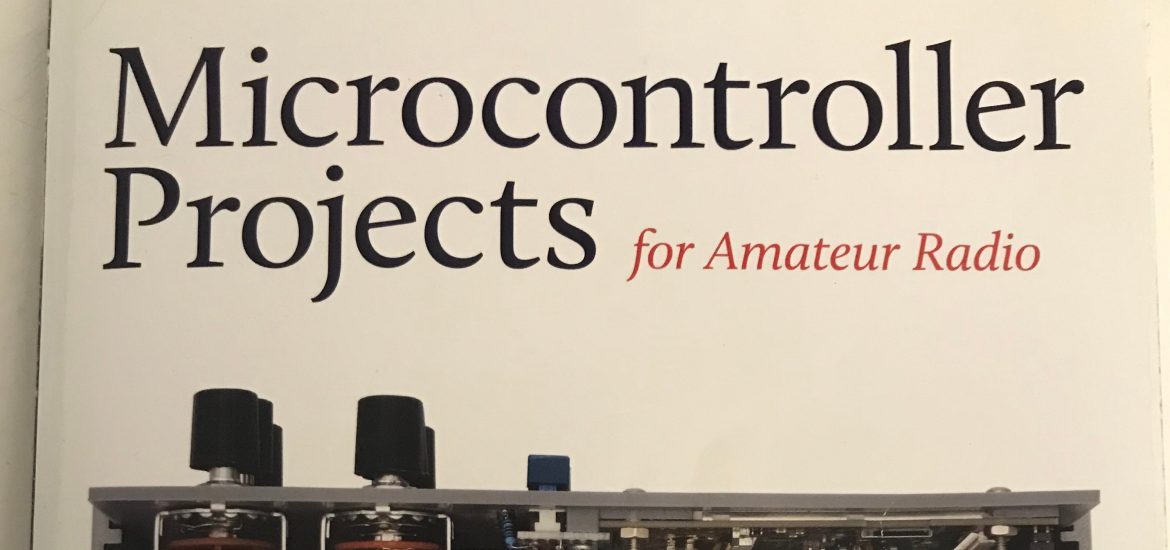Book Review
“Microcontroller Projects for Amateur Radio” is a great book for folks with some background with microcontrollers
and have a knack for improvising and troubleshooting. That may sound like a left-handed complement, but read on.

It was submitted to ARRL for publication two years before it hit the ARRL Store. Every schematic was redrawn, which introduced some errors. As you can imagine, in the intervening two years, microcontroller technology advanced significantly, to the extent that the microcontrollers (hereafter: uC) referenced in the schematics had evolved into a myriad of flavors, some with different pinouts, some with more or less memory, different supply
voltages, etc. The good news is that Groups.io has a very active group () in which author Jack Purdum, W8TEE, is very active. He and co-author Al Peter, AC8GY, answer questions, clarify issues and post updates to schematics, code, PCB Gerber files, etc. The group is very active, and I tip my hat to Jack for being so involved.
The book offers designs for devices almost every ham has, or could use, or lusts after, in their shack, ranging from Mini Dummy Load, Morse Code Tutor (more on that in a bit), Programmable Bench Power Supply, 100W Tuner with Graphical SWR Analyzer, a CW Messenger, a DSP Post Processor, DSP Audio Mic-processor, Signal Generator, and a Double –Double Magnetic Loop and Controller HF Antenna (an impressive piece of kit: 4 parallel loops with motor-driven tuning cap).
All project code is written in C; knowing C is helpful but not a requirement. Jack wrote a book on C, “Beginning C
For Microcontollers”, which could be very helpful to spin up on the language.
I was designing the code for my own Morse Code Trainer when I saw the book and wanted to see what their code looked like – I don’t mind using others’ code, why reinvent the round wheel. The authors strongly recommend (“require”?) reading the first two chapters. Bah, I just jumped in and compiled their MCT code. Or tried. I had manifest problems, related entirely to the way my Arduino development environment was installed. After following Jack’s suggestion to actually read the first two chapters, I was off to the races. Proper setup of the development environment with the current Arduino IDE (Integrated Development Environment) is important, and the C book goes into great detail about that.
Another issue is that the code, fully compiled and tested prior to submission, relies on libraries in the public domain written by others (it’s the “round wheel” thing). Over the course of the prepublication two years, some of the libraries were modified by the original author or others, often leaving the library name the same. Many code compilation or function problems reported by Groups.io readers related to modified libraries. Fortunately the myriad of folders in the Software Controlled Ham Radio on Groups.io contain all the necessary code. And the folder structure was recently redone to make navigation and file retrieval must easier. The folders contain code, schematics, Gerber files for PCBs, some even contain STL files for 3D prints.
The projects are as follows:
The Mini Dummy Load is small enough to carry along on camping trip, etc., and can handle up to 50W for 10 seconds, depending on the power resistor used.
The MCT trains sending and receiving, using Koch and Farnsworth settings, up to 30WPM. It sends numbers, letters, punctuation, words, letter/number combinations, call signs, simulated QSOs, it allows the operator to send 2 letters at a time, a mix of letters/numbers and has a “flashcard” feature. It allows use of paddles or a straight key. I built mine on a breadboard, as there are only six components, although something more permanent would make it more portable. Jack’s code is cleaner and more functional than mine would ever have been :-p.
The Programmable Bench Power Supply can be powered from 12 to 25VDC, so can be used in the field. It will output up to 3A (with minor additions can go to 10A), regulated output under load, low noise, variable current limit and has a menu-driven UI using three rotary encoders (a touch screen can be added). Voltage control is via course and fine tuning encoders or a built-in keypad.
The 100W Antenna Tuner with Graphical SWR Analyzer is two must-have instruments in one, and can be built for as little as $40 or $50! The unit works from 80 to 10 meters and will display the SWR real time as the antenna is tuned via dials on the front panel.
The CW Messenger is basically a memory “keyer”, which sends canned messages at the press of a button; many modern transceivers have this function built-in. This box is different from other memory keyers in that the message(s) can be input or modified via a touch screen, which makes it much less error-prone than using a key.
The DSP Post Processor, again, a built-in feature on most modern transceivers, features variable low-pass, high-pass, band-pass filters with up to 160dB/decade filter skirts, notch filter with variable Q, auto notch filter, FFT display, DSP noise reduction, power final amp to drive less efficient speakers, multiple inputs, dual channel and more. It’s a pretty powerful device but a very straightforward build.
The DSP Audio Mic-processor provides digital signal processing for rigs which don’t have that feature. It provides automatic speech compressor, multi-band equalizer, and FFT display and will interface with both dynamic and capacitor/electret mics. Of course there are commercial units available, many costing hundreds of dollars, but this design can be built rather easily for about $70.
The signal generator design has seen the most activity on the listserv, as the AD9851 and AD9833 A/D converters have proven very hard to find. The design is quite complex, as you might expect, so a PCB design is provided on the listserv. The SG appears to be a full-featured design, comparable to many professional units, but constructible for less money. It features two channels, 10 HZ to 40 MHZ, sine wave only, and 10 HZ to 10 MHZ on channel B with sine, square and triangle wave functions; modulated (AM or FM), attenuators, 1 HZ frequency resolution with better than 0.3 PPM stability, and many other features.
The Double-Double Magnetic Loop is a really nice piece of kit. It appeals to me because it is remotely tunable: a variable capacitor is belt-driven by a small stepper motor. The antenna consists of two loops in parallel with two more loops. This luggable 40 meters thru 10 meters antenna is only 0.1 meter in diameter, so will easily fit in a car trunk. Most of the built effort would be mechanical, involving bending ½” copper pipe, cutting PVC pipe and spacers and fabricating mounts for the variable cap, motor, gears and belt drive.
The electronics for the Controller are straightforward enough that the controller may be built on a prototype board. The controller features, auto-tune, once a frequency has been selected via front panel knob; a TFT display for frequency and SWR display, fine tuning during operation, stepper motor presets and remote band switching. For hams who are antenna-constrained because of HOAs, or hams who want a good antenna while camping, the Double-Double ML and Controller might be just the ticket.
The following uCs are used: STM32F, ESP32, Teensy 4.0 and the Arduino Nano and Mega2560 Pro Mini. A compounding problem, not unique to this book, is that cheap Chinese knockoffs of the uCs usually didn’t work but the failures weren’t consistent, so there were many conversations on the listserv about that.
Bottom line: If any of these projects pique your interest, get a Groups.io login, buy the book and have fun. These projects can be an excellent adjunct to Cam’s “Winter Build Projects”. Let’s make some solder smoke!
